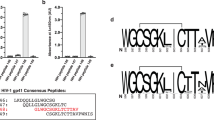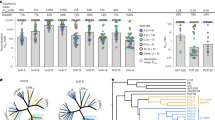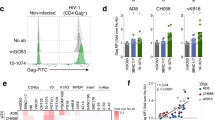Abstract
The ability of human immunodeficiency virus (HIV-1) to persist and cause AIDS is dependent on its avoidance of antibody-mediated neutralization. The virus elicits abundant, envelope-directed antibodies that have little neutralization capacity1. This lack of neutralization is paradoxical, given the functional conservation and exposure of receptor-binding sites on the gp120 envelope glycoprotein, which are larger than the typical antibody footprint2 and should therefore be accessible for antibody binding. Because gp120–receptor interactions involve conformational reorganization3, we measured the entropies of binding for 20 gp120-reactive antibodies. Here we show that recognition by receptor-binding-site antibodies induces conformational change. Correlation with neutralization potency and analysis of receptor–antibody thermodynamic cycles suggested a receptor-binding-site ‘conformational masking’ mechanism of neutralization escape. To understand how such an escape mechanism would be compatible with virus–receptor interactions, we tested a soluble dodecameric receptor molecule and found that it neutralized primary HIV-1 isolates with great potency, showing that simultaneous binding of viral envelope glycoproteins by multiple receptors creates sufficient avidity to compensate for such masking. Because this solution is available for cell-surface receptors but not for most antibodies, conformational masking enables HIV-1 to maintain receptor binding and simultaneously to resist neutralization.
This is a preview of subscription content, access via your institution
Access options
Subscribe to this journal
Receive 51 print issues and online access
$199.00 per year
only $3.90 per issue
Buy this article
- Purchase on Springer Link
- Instant access to full article PDF
Prices may be subject to local taxes which are calculated during checkout


Similar content being viewed by others
References
Weiss, R. A. et al. Neutralization of human T-lymphotropic virus type III by sera of AIDS and AIDS-risk patients. Nature 316, 69–72 (1985)
Kwong, P. D. et al. Structure of an HIV gp120 envelope glycoprotein in complex with the CD4 receptor and a neutralizing human antibody. Nature 393, 648–659 (1998)
Myszka, D. G. et al. Energetics of the HIV gp120-CD4 binding reaction. Proc. Natl Acad. Sci. USA 97, 9026–9031 (2000)
Dalgleish, A. G. et al. The CD4 (T4) antigen is an essential component of the receptor for the AIDS retrovirus. Nature 312, 763–767 (1984)
Feng, F., Broder, C. C., Kennedy, P. E. & Berger, E. A. HIV-1 entry co-factor: functional cDNA cloning of a seven-transmembrane, G protein-coupled receptor. Science 272, 872–877 (1996)
Klatzmann, D. et al. T-lymphocyte T4 molecule behaves as the receptor for human retrovirus LAV. Nature 312, 767–768 (1984)
Posner, M. R. et al. An IgG human monoclonal antibody that reacts with HIV-1/GP120, inhibits virus binding to cells, and neutralizes infection. J. Immunol. 146, 4325–4332 (1991)
Thali, M. et al. Characterization of conserved human immunodeficiency virus type 1 (HIV-1) gp120 neutralization epitopes exposed upon gp120-CD4 binding. J. Virol. 67, 3978–3988 (1993)
Burton, D. R. et al. Efficient neutralization of primary isolates of HIV-1 by a recombinant human monoclonal antibody. Science 266, 1024–1027 (1994)
Moore, J. P. & Sodroski, J. Antibody cross-competition analysis of the human immunodeficiency virus type 1 exterior envelope glycoprotein. J Virol. 70, 1863–1872 (1996)
Trkola, A. et al. Human monoclonal antibody 2G12 defines a distinctive neutralization epitope on the gp120 glycoprotein of human immunodeficiency virus type 1. J. Virol. 70, 1100–1108 (1996)
Rizzuto, C. D. et al. A conserved human immunodeficiency virus gp120 glycoprotein structure involved in chemokine receptor binding. Science 280, 1949–1953 (1998)
Binley, J. M. et al. Analysis of the interaction of antibodies with a conserved, enzymatically deglycosylated core of the HIV-1 gp120 envelope glycoprotein. AIDS Res. Hum. Retroviruses 14, 191–198 (1998)
Stites, W. E. Protein–protein interactions: interface structure, binding thermodynamics, and mutational analysis. Chem. Rev. 97, 1233–1250 (1997)
Kwong, P. D. et al. Structures of HIV-1 gp120 envelope glycoproteins from laboratory-adapted and primary isolates. Structure 8, 1329–1339 (2000)
Luque, I. & Freire, E. A system for the structure-based prediction of binding affinities and molecular design of peptide ligands. Methods Enzymol. 295, 100–127 (1998)
Fouts, T. R., Binley, J. M., Trkola, A., Robinson, J. E. & Moore, J. P. Neutralization of the human immunodeficiency virus type 1 primary isolate JR-FL by human monoclonal antibodies correlates with antibody binding to the oligomeric form of the envelope glycoprotein complex. J. Virol. 71, 2779–2785 (1997)
Sullivan, N. et al. CD4-induced conformational changes in the human immunodeficiency virus type 1 gp120 glycoprotein: consequences for virus entry and neutralization. J. Virol. 72, 4694–4703 (1998)
Salzwedel, K., Smith, E. D., Dey, B. & Berger, E. A. Sequential CD4-coreceptor interactions in human immunodeficiency virus type 1 env function: soluble CD4 activates env for co-receptor-dependent fusion and reveals blocking activities of antibodies against cryptic conserved epitopes on gp120. J. Virol. 74, 326–333 (2000)
Moore, J. P., McKeating, J. A., Huang, Y. X., Ashkenazi, A. & Ho, D. D. Virions of primary human immunodeficiency virus type 1 isolates resistant to soluble CD4 (sCD4) neutralization differ in sCD4 binding and glycoprotein gp120 retention from sCD4-sensitive isolates. J. Virol. 66, 235–243 (1992)
Arthos, J. et al. Biochemical and biological characterization of a dodecameric CD4-Ig fusion protein. Implications for therapeutic and vaccine strategies. J. Biol. Chem. 277, 11456–11464 (2002)
Zhu, P., Olson, W. C. & Roux, K. H. Structural flexibility and functional valence of CD4-IgG2 (PRO 542): Potential for cross-linking human immunodeficiency type 1 envelope spikes. J. Virol. 75, 6682–6686 (2001)
Traunecker, A., Schneider, J., Kiefer, H. & Karjalainen, K. Highly efficient neutralization of HIV with recombinant CD4-immunoglobulin molecule. Nature 339, 68–70 (1989)
Wyatt, R. et al. The antigenic structure of the human immunodeficiency virus gp120 envelope glycoprotein. Nature 393, 705–711 (1998)
Doyle, M. L. et al. Measurement of protein interaction bioenergetics: application to structural variants of anti-sCD4 antibody. Methods Enzymol. 323, 207–230 (2000)
Zhou, J. Y. & Montefiori, D. C. Antibody-mediated neutralization of primary isolates of human immunodeficiency virus type 1 in peripheral blood mononuclear cells is not affected by the initial activation state of the cells. J. Virol. 71, 2512–2517 (1997)
Kwong, P. D., Wyatt, R., Sattentau, Q. J., Sodroski, J. & Hendrickson, W. A. Oligomeric modeling and electrostatic analysis of the gp120 envelope glycoprotein of the human immunodeficiency virus. J. Virol. 74, 1961–1972 (2000)
Wyatt, R. et al. Analysis of the interaction of the human immunodeficiency virus type 1 gp120 envelope glycoprotein with the gp41 transmembrane glycoprotein. J. Virol. 71, 9722–9731 (1997)
Fung, M. S. et al. Identification and characterization of a neutralization site within the second variable region of human immunodeficiency virus type 1 gp120. J. Virol. 66, 848–856 (1992)
Rusche, J. R. et al. Antibodies that inhibit fusion of human immunodeficiency virus-infected cells bind a 24-amino acid sequence of the viral envelope, gp120. Proc. Natl Acad. Sci. USA 85, 3198–3202 (1988)
Acknowledgements
We thank M. Dybul for providing primary isolates pi102, pi104, pi202 and pi204; M. A. Gawinowisc for matrix-assisted laser desorption/ionization–time of flight analysis; Z. Moodie and A. Palmer for help with error analysis; A. Fauci, S. Harrison, A. Miranker, R. Seder and L. Shapiro for discussions; and D. Dimitrov, B. Kwong, N. Letvin, J. Mascola, G. Nabel and Q. Sattentau for comments. This work was supported by grants from the National Institutes of Health and by a Center for AIDS Research grant to the Dana-Farber Cancer Institute. The Dana-Farber Cancer Institute is also the recipient of a Cancer Center Grant from the National Institutes of Health. Columbia University is a participant in a Center for AIDS Research. R.W. was a fellow of the American Foundation for AIDS Research and P.D.K. was a recipient of a Burroughs Wellcome Career Development award.
Author information
Authors and Affiliations
Corresponding author
Ethics declarations
Competing interests
The authors declare that they have no competing financial interests.
Rights and permissions
About this article
Cite this article
Kwong, P., Doyle, M., Casper, D. et al. HIV-1 evades antibody-mediated neutralization through conformational masking of receptor-binding sites. Nature 420, 678–682 (2002). https://doi.org/10.1038/nature01188
Received:
Accepted:
Issue Date:
DOI: https://doi.org/10.1038/nature01188
This article is cited by
-
Human monoclonal antibodies inhibit invasion of transgenic Plasmodium knowlesi expressing Plasmodium vivax Duffy binding protein
Malaria Journal (2023)
-
Profound structural conservation of chemically cross-linked HIV-1 envelope glycoprotein experimental vaccine antigens
npj Vaccines (2023)
-
Chemical inhibition of DPP9 sensitizes the CARD8 inflammasome in HIV-1-infected cells
Nature Chemical Biology (2023)
-
Trapping the HIV-1 V3 loop in a helical conformation enables broad neutralization
Nature Structural & Molecular Biology (2023)
-
High thermostability improves neutralizing antibody responses induced by native-like HIV-1 envelope trimers
npj Vaccines (2022)
Comments
By submitting a comment you agree to abide by our Terms and Community Guidelines. If you find something abusive or that does not comply with our terms or guidelines please flag it as inappropriate.



